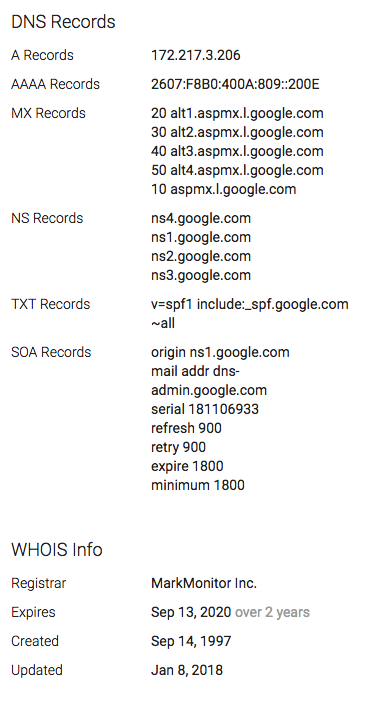Domains
IT Glue provides a domain tracker to ensure that you are kept notified of expiring domain names.
Even if you have hundreds of domains to track, you can be notified on all domains or a subset of domains using our workflows feature. These notifications can be sent to multiple recipients so you can be sure to never miss an important renewal. Expiring domains are also shown on the Global > Expirations report.
As well as performing a domain expiry check, we also collect, store, and periodically update WHOIS information and key DNS records, for example, A, NS, MX, TXT, and SOA records. Also, if there is an SSL certificate installed at that domain name, the public aspects of the certificate are automatically added to the SSL tracker.
Learn more about the domain and SSL certificate tracker in this IT Glue express video (2:07):
VIDEO IT Glue express video
The Domain Tracker automatically creates an SSL certificate in the SSL Tracker. Please note that the Domain hostname and SSL certificate common name must match in order for the Domain Tracker to auto-create the SSL certificate. If these values does not match, the SSL certificate will not be automatically created and you will need to create it manually. For more information about the SSL tracker, refer to SSL certificates.
Preparation
- Sign into domain registrar accounts or hosting service accounts.
- Request domain information from key site contacts. Many organizations have multiple domains, even if some are parked domains or forwarders.
- Create passwords in IT Glue for the associated providers.
Instructions
Follow these steps to capture all known domains (for example, client.com, client.ca, client.co.uk, client.com.au, client.co.nz) in IT Glue:
- Navigate to the organization that the domain belongs to.
- From the left navigation menu, click Domain Tracker.
- In the upper-right corner of the page, click New.
- In the Domain Name field, enter the fully qualified domain name (FQDN) of the domain.

- Click Save.
- Wait a few moments and then refresh the page. WHOIS and DNS information will automatically populate.

Make sure everything looks correct. Certain registrars produce WHOIS data in way that can't be parsed. Because of this, date values coming from these registrars are not always retrieved automatically in which case you will need to manually enter the associated date values.
NOTE WHOIS information for the .health and.nz domains cannot be retrieved via the API, which means these TLDs are currently not supported in IT Glue.
Common questions
Will the SSL tracker automatically add the domain's SSL certificate?
Yes, when you add a domain that has an SSL certificate (the padlock appears in the address bar when viewing an https site), it goes through a two step process:
- Fetch the WHOIS and DNS information and store them in the domain tracker.
- Fetch public aspects of the certificate and store them in the SSL tracker.
How often will WHOIS and DNS information be updated?
The expiration date of the domain will determine how often the WHOIS information is updated.
IT Glue will check for WHOIS information changes on a monthly basis for all domains. Once a domain is close to its expiration date, this WHOIS check becomes more frequent:
- Domains that expire in the next 90 days are checked once a week.
- Domains that expire in the next 30 days are checked every other day.
IT Glue checks for DNS changes on a daily basis. When DNS changes are made, it takes time for the changes to propagate to the rest of the internet, so please account for this. When we see the change, we will automatically record it.
Each time a domain update is determined, it is recorded as a new version. When viewing the domain record, recent versions display in the right panel under Revisions.
If an update fails, the system makes five attempts, and then waits a week before trying again.
Can the information be manually refreshed?
Yes, you are welcome to manually refresh the information at any time. When viewing the domain in IT Glue, click the Refresh DNS and WHOIS button and wait for the information to populate.



